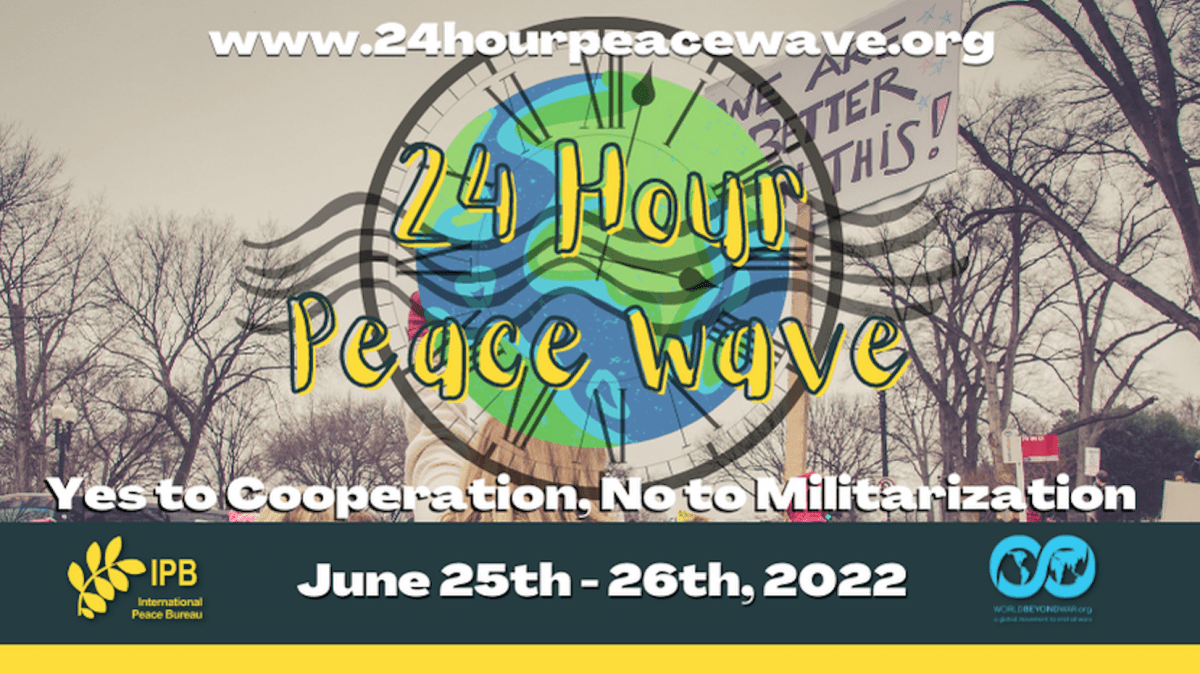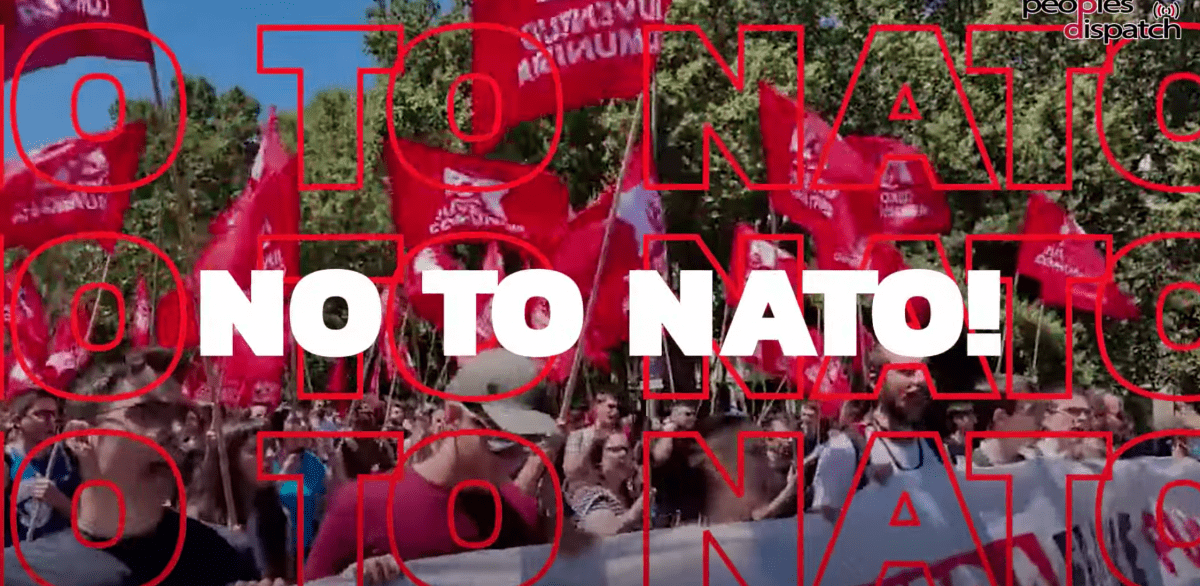In times of increasing armament and ever-growing insecurities, with current discussions that retrieve fears and traumas from the past century – mistakes that the global community should have overcome – we can still find hope in the actions of those committed to a world without war, with less militarization and more cooperation. For a deeply and widely spread message, only a movement of global reach could connect different voices of the world around the common and ubiquitous demand for peace.
To achieve that, The International Peace Bureau and World BEYOND War organized the very first 24 Hour Peace Wave in protest of excessive military spending and the expansion of NATO, which took place from the 25th to the 26th of June, as a counter-action to the NATO Summit in Madrid and the 48th G7 Summit in Munich, with both also taking place at the end of June. The event served to speak up for peace and cooperation, the scaling back and dismantling of military alliances, the disarmament of governments, and the democratization and strengthening of international institutions of nonviolent cooperation and the rule of law.
This was a one-of-a-kind global rally for Peace and cooperation around the clock, with twenty-four non-stop hours of protests, demonstrations, vigils, teach-ins, speakers, discussion rounds, music, and art from all around the world. To achieve maximum reach, the event was recorded and livestreamed simultaneously across four major social media channels (YouTube, Facebook, Twitter and LinkedIn), moving West around the globe from 2:00pm in the UK on June 25th to 4:00pm in Ukraine on June 26th. The participants had the opportunity to choose between various sessions to join, depending on which part of the world they were in at the time of the event. Divided in twelve different sections, the Peace Wave could be nothing short of a spectacular global appeal for Peace.
The first section started with live street demonstrations directly from city centre of London, United Kingdom – we had speeches, protests, banners and music being played to all of those passing by. We even had some contributions from a protest regarding Sudan. At the end of the session were displayed videos provided to us directly from Western Sahara, instructing the viewers and participants about their culture and current struggles. And to compliment that, more musical contributions.
The second section covered most of South America, bringing contributions from various voices of different countries: Chile, Argentina, Perú, Ecuador, and Brazil. We had the opportunity to learn more about the political structures and struggles of these people, their past, and the actions currently taken to promote peace by music, youth organizations and political engagement against increasing militarization and armament by governments.
The third section was established to cover the Atlantic side of the United States, starting with a great demonstration in Manhattan, at the centre of New York City – poetry, songs, theatre and speeches from many contributors. We also had a poetic participation from Ontario, Canada, beautiful banners, kites and music from Long Island, and a big rally in Asheville, North Carolina.
The fourth section took us back to Latin America, now addressing countries such as Mexico, Honduras, El Salvador, Venezuela, Argentina, the Dominican Republic and Colombia. In this section we followed an important round table of discussions, with many interesting contributions and points of view on Peace education, popular participation, and Human Rights in the face of the dangers of militarization.
The fifth section covered the Pacific side of the United States. We started in the state of Washington, with music, prayers, and a small discussion on military bases at the Pacific side. We had videos from a protesting flashmob, a theatrical piece, and discussions on military environmental impact. Beyond that, we had contributions from Vancouver and Victoria in Canada, and also from California.
The sixth section started in Hawaii, with a poetic contribution regarding a “world without RIMPAC”. We had recordings, poetry and documentaries about military presence on the islands, hearing from natives about how it all impacts their original land. From Guam, we also had a glimpse into the destructive presence of nuclear testing in the pacific and the militarization of the seas.
The seventh section brought us words from Australia and New Zealand. In the first half we had speeches, interviews, choir songs, presentations and protests from many parts of Australia regarding many themes around Peace. From New Zealand, we also had a series of talks, music, and outdoor events, including voices from native peoples and youth.
The eighth section, starting in Japan, presented us a live protest in the streets of Tokyo – a street campaign with speeches, testimonials, signs and music against war, militarization and the use of nuclear weapons. Next in the rally, we had contributions from South Korea talking about RIMPAC exercises, military presence at the peninsula. From the streets, a demonstration with protesting theatre, dance and signs against NATO.
The ninth sections, conducted by the Philippines, brought us multiple artistic contributions to delegitimize NATO, against all imperialism, proxy wars and general sanctions. We had a real-time panel being painted by artists. Poetry, dances, testimonials and different genres of music established the tone of protests here, with many young people participating and helping in this intensive rally.
The tenth section was made by an international participation of people from Afghanistan, Bangladesh, India, Pakistan, Sri Lanka and Nepal. We had poetry, prayers, paintings, messages, protests and even the presence of state figures. We heard about Positive Peace, media manipulation, economics of Peace, including voices of natives and refugees at our peace wave.
The eleventh section started with a German song and a welcome message from Berlin. Why “no to NATO” from Hungary, and a Livestream intervention from Sinjajevina, Montenegro. From Cameroon we heard about Disarmament for Development, and from Czech Republic words on nuclear disarmament. We had protests from Barcelona and live rallies from Rammstein and Madrid.
The twelfth section, concluded the peace wave with voices from Norway, Finland and Lebanon in an interesting panel discussion about Peace, collaboration, democratization, media and security challenges from peace activists. We also had major live statements from peace activists from Iran, Kenya and Ukraine addressing important topics and their experiences in the struggle for peace.
This peace wave gathered contributions from 39 different countries, not to include the different regions within a given country. From all these contributions, we had close to 200 people collaborating with messages and art from all over the world addressing one common demand: No to militarization, yes to cooperation. Peace was the leading word for those twenty-four hours of activities.
The event was open to the public, with hundreds of people joining from different parts of the world across major social media channels and an average of 50-60 participating directly via Zoom. Being the first-of-its-kind Peace action, our hope is to continue down this path in the years to follow. Many thanks to all who squeezed time out their busy schedule to ensure that this event was a success.
To sum up all the content that we had in this first peace wave we compiled a video with the highlights of the event:
This video serves as a brief highlight of the many activities we had, so you can be sure that much more can be found in the recordings. To have access to the recording of the 24 hours of our event, access this link:
https://worldbeyondwar.org/videos-from-the-24-hour-peace-wave/
The International Peace Bureau (IPB) and World BEYOND War would like to thank all the participants and viewers from all around the world who were present with us directly via Zoom or indirectly in the livestreams (Youtube, Facebook, LinkedIn and Instagram). A special message of appreciation to all the coordinators for each section, who accepted the challenge to organize the twelve different parts of two hours, dedicating much of their time and effort in the two months prior to the day of the event.
Berlin, July 2022.


